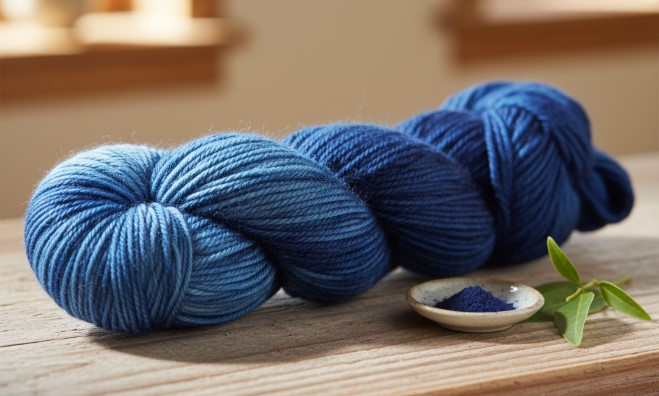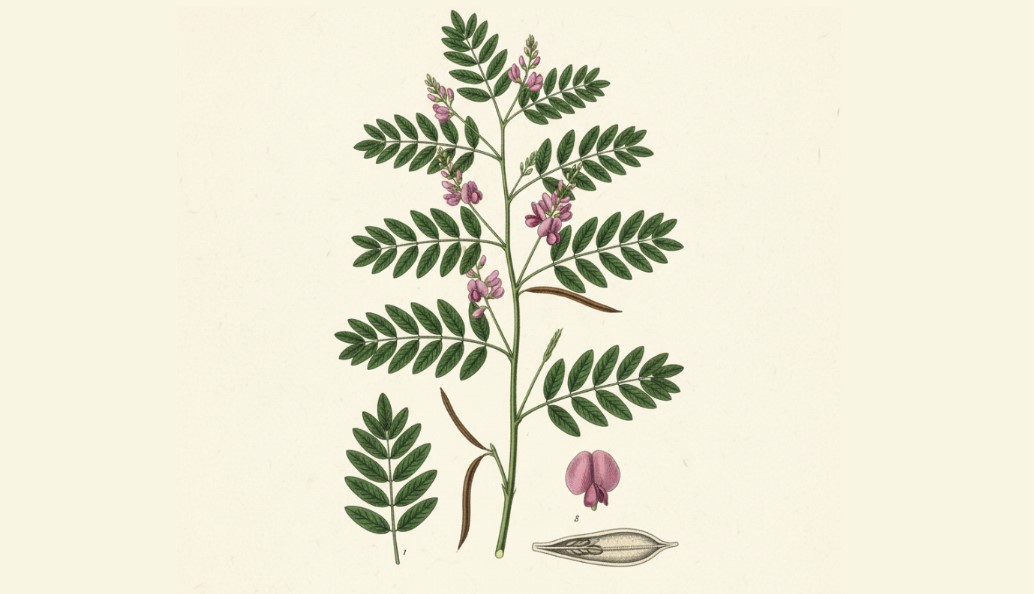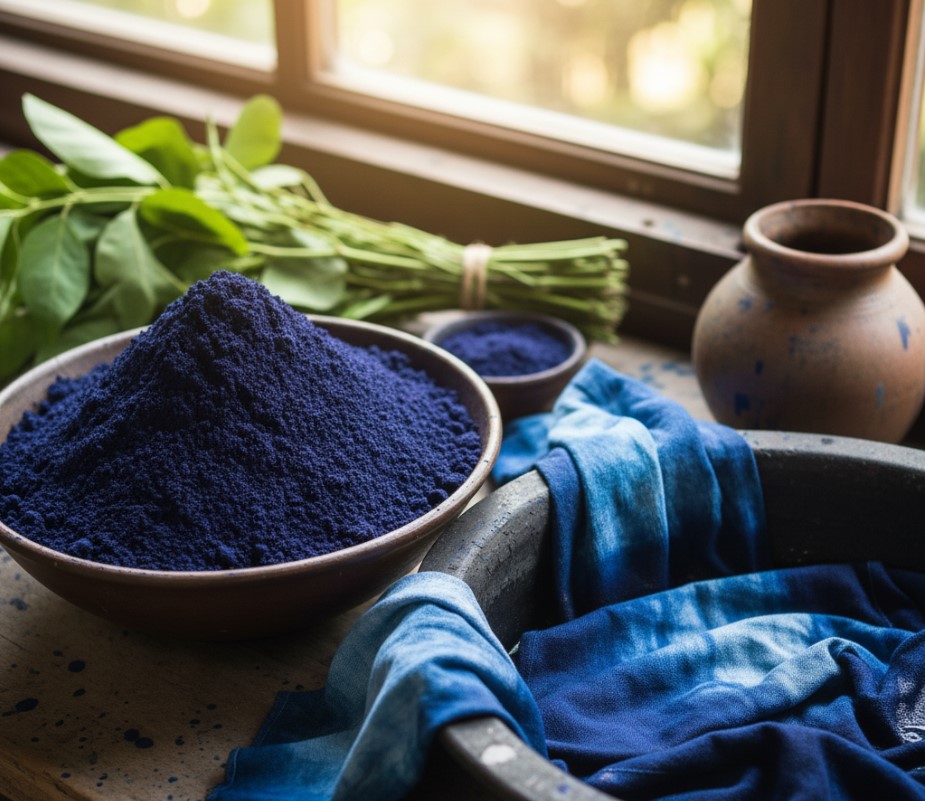The Reality of Indigo: What Makes It Different

Every other natural dye is simpler. You extract color from plants, mordant your fiber, apply heat. Indigo ignores all of that.
It won't dissolve in water. It needs fermentation. The dye bath looks yellow-green, not blue. And when you pull fabric out, it changes color in front of you - yellow-green oxidizing to blue in real time as oxygen hits the pigment molecules.
This is why indigo has captivated dyers for millennia, and why it occupies its own category in natural dyeing. The chemistry is different. The process is different. The results are different.
Here's what actually makes indigo work, and why it's unlike any other natural dye you'll encounter.
The Chemistry That Makes Indigo Unique
Most natural dyes are water-soluble. Dissolve them in hot water, and they'll bond to fiber. Indigo doesn't work that way.
The indigo molecule - indigotin - is completely insoluble in water. You can simmer indigo leaves in a pot for hours and get nothing. The blue pigment stays locked in the plant material, chemically unavailable.
To make indigo work, you need to change its molecular structure through a process called reduction. This removes oxygen from the indigo molecule, converting it into a form called leucoindigo. Leucoindigo is water-soluble and yellow-green in color.
This is what a functioning indigo vat contains: leucoindigo suspended in an oxygen-free, alkaline solution.
When you submerge fabric in this vat, leucoindigo penetrates the fibers. Pull the fabric out, and oxygen from the air reattaches to those leucoindigo molecules. They convert back to indigotin - insoluble blue pigment - now trapped inside your fabric.
The color change happens in seconds. Visible oxidation. Chemistry you can watch.
No other natural dye operates this way.
What "Reducing" Indigo Actually Means
The term "reduction" refers to the chemical process that makes indigo soluble. In chemistry, reduction means removing oxygen from a molecule or adding electrons. Both definitions apply to indigo.
Historical methods used fermentation to create reduction. Dyers would mix indigo with organic materials (wheat bran, fruit, sometimes urine) and beneficial bacteria. The bacteria consumed oxygen in the vat and produced the alkaline conditions leucoindigo needs.
Fermentation vats take days to develop, require constant temperature maintenance, and emit a smell that's... distinctive. Earthy. Sour. Unmistakably biological. Some dyers describe it as pleasant; most describe it as intense.
Modern indigo reduction often uses chemicals instead: sodium hydrosulfite or thiourea dioxide. These create an oxygen-free environment in minutes rather than days. The chemistry is the same - indigo becomes leucoindigo - but the method bypasses fermentation entirely.
Both approaches have adherents. Fermentation vats are considered more traditional, more aligned with historical practice. Chemical reduction is faster, more predictable, easier to maintain.
The fabric doesn't know the difference. Either method produces the same blue.
Why the Vat Looks Yellow-Green, Not Blue
This confuses people initially. You're dyeing something blue. The vat is yellow-green. It seems wrong.
It's not. That yellow-green color is leucoindigo - the reduced, soluble form of indigo that actually penetrates fiber. If your vat looks blue, something's wrong. Blue indigo means oxidized, insoluble indigo. It won't dye anything.
A properly functioning indigo vat has these characteristics:
- Yellow-green liquid with no blue visible in the body of the vat
- Blue foam or "flower" on the surface where leucoindigo contacts oxygen
- Clear zones where the vat has been undisturbed
- Alkaline pH usually between 10-11
- Reduced smell either biological (fermentation) or chemical (hydrosulfite)
Dyers learn to read their vat. The color, the foam, the smell - these indicate whether the chemistry is working.
When conditions drift (too much oxygen, wrong pH, depleted reducing agent), the vat starts showing blue in the liquid. That's oxidized indigo suspended in water. Unusable. The vat needs adjustment: more reducing agent, higher pH, time to settle.
The Color Change: Watching Oxidation Happen
This is the moment that hooks people on indigo.
You pull fabric from the yellow-green vat. It emerges yellow-green. Not blue. And then - in front of you, as you hold it - it shifts.
Yellow-green darkens to teal. Teal deepens to turquoise. Turquoise becomes true blue. The transformation takes fifteen to thirty seconds depending on temperature and humidity. Faster in dry air, slower in humid conditions.
You're watching oxidation. Oxygen molecules from the air attaching to leucoindigo molecules in the fabric, converting them back to indigotin. The insoluble blue pigment that won't wash out.
No other natural dye does this. Madder dyes red immediately. Weld dyes yellow immediately. Logwood dyes purple immediately. The color you see in the dye pot is the color you get.
Indigo requires that intermediate step. Reduction to make it soluble, oxidation to make it blue.
Building Depth: Why Indigo Is Dipped Multiple Times
Light indigo blue comes from one dip. Deep navy requires ten to twenty dips, sometimes more.
Each immersion adds another layer of indigo molecules to the fiber. One dip gives you pale sky blue. Three dips produce medium blue. Six dips create deep blue. Fifteen dips approach black.
The process: dip fabric in the vat, pull it out, let it oxidize fully (usually five to ten minutes), then dip again. Repeat until you reach the depth you want.
Some fabrics show variation within a single piece - lighter at the edges where the fabric entered the vat first, darker in the center. This happens because leucoindigo concentration decreases as it bonds to fiber. The first section through the vat gets more dye than the last section.
Dyers either embrace this variation (natural unevenness as part of the aesthetic) or manage it through careful fabric manipulation and additional dips.
Sources of Indigo: Plant vs. Synthetic
True indigo - indigotin - comes from several plant species:

Indigofera tinctoria is the most famous, cultivated extensively in India and historically central to global indigo trade. High indigo content, reliable yields.
Persicaria tinctoria (Japanese indigo) grows easily in temperate climates, produces good color, and is popular with home dyers growing their own indigo.
Isatis tinctoria (woad) was Europe's indigo source before trade routes opened. Lower indigo content than Indigofera, but the chemical structure is identical. Woad and indigo produce the exact same blue.
The plants differ in cultivation requirements and indigo concentration, but the pigment they contain is molecularly identical. Indigotin from any source behaves the same way in a vat.
Then there's synthetic indigo.

Discovered in 1878, perfected by 1897, synthetic indigo crashed the natural indigo market within a decade. It's chemically identical to plant indigo - same molecule, same structure - but produced through industrial synthesis rather than grown in fields.
Most denim is dyed with synthetic indigo. Most commercial blue textiles use synthetic indigo. The molecular structure is indistinguishable from plant-derived indigo.
The difference shows up in context: environmental impact of synthesis vs. agriculture, labor conditions in chemical plants vs. indigo farms, economics of commodity markets vs. small-batch natural dyeing.
The chemistry on your fabric is identical.
Temperature, Time, and Vat Maintenance
Indigo vats function within a narrow range of conditions.
Temperature: Most vats work best between 80-110°F (27-43°C). Too cold, and the reduction slows or stops. Too hot, and you kill beneficial bacteria in fermentation vats or accelerate chemical reactions beyond control.
pH: Leucoindigo needs alkalinity to stay soluble, typically pH 10-11. Traditional vats used wood ash or lime for alkalinity. Modern vats often use soda ash or lye. As the vat works, pH drops. Dyers monitor this and adjust accordingly.
Oxygen exposure: Minimized through careful fabric handling. Don't agitate the vat. Don't introduce air bubbles. Lower fabric gently, lift it smoothly. Every bit of oxygen that enters oxidizes leucoindigo before it can bond to fiber.
Time: Fabric typically stays in the vat for 5-15 minutes, depending on the dyer's preference and vat strength. Longer doesn't always mean darker - once fiber is saturated with leucoindigo, additional time adds nothing. Depth comes from multiple dips, not extended immersion.
Fermentation vats need feeding. Dyers add organic material (fruit, wheat bran, molasses) to sustain bacterial activity. Chemical vats need periodic additions of reducing agent as it depletes.
An active indigo vat can last months with proper maintenance. Some dyers keep vats going continuously through dyeing season. Others build a vat for specific projects, then let it exhaust.
Why Indigo Doesn't Need Mordants
Almost every other natural dye requires mordants - metal salts that help pigment bond to fiber permanently. Alum, iron, copper, tin. These create chemical bridges between dye molecules and fiber molecules.
Indigo doesn't need them.
The indigo molecule is large enough and structured in a way that allows it to physically lodge in fiber without chemical bonding. Think of it as mechanical entrapment rather than chemical adhesion.
This is why indigo fades in a particular way. It doesn't wash out evenly like poorly-mordanted dyes. It abrades. The surface layers wear away through friction, revealing lighter layers beneath. This creates the characteristic high-contrast fading pattern of denim - bright blue in protected areas, pale blue where the fabric experiences friction.
The indigo is still there, just buried under layers of oxidized indigo that have worn away.
The Cultural Weight of Indigo
Indigo was global currency for centuries. Indigo cakes - compressed indigo pigment extracted from leaves - were shipped from India, traded across the Silk Road, valued alongside gold and spices.
The color was expensive enough to legislate. Sumptuary laws in medieval Europe restricted who could wear indigo blue. The pigment was valuable enough to enslave people for. Indigo plantations in the American South and Caribbean relied on enslaved labor for cultivation and processing.
Japan developed katazome and shibori techniques specifically for indigo. West African cultures created complex resist-dye traditions with indigo. Indian block printing reached refinement using indigo alongside other natural dyes.
The chemistry made it valuable. The color made it desirable. The labor made it ethically complicated.
Modern indigo dyeing exists in this context. Some dyers engage with the history explicitly - acknowledging the labor and trade systems that made indigo globally dominant. Others focus on the craft itself, the chemistry, the color.
The blue carries all of it.
What Indigo Requires from Dyers
Indigo demands attention in ways other natural dyes don't.
You can't prepare an indigo vat and ignore it. The chemistry drifts. Oxygen infiltrates. pH shifts. Reduction depletes. A vat working perfectly today might be sluggish tomorrow without adjustment.
This makes indigo both frustrating and engaging. You develop a relationship with the vat. You learn to read it - what the color means, what the smell indicates, how the foam patterns reveal vat health.
Some dyers find this tedious. Others find it meditative. All agree: indigo is temperamental.
But the results are unmatched. That blue - the depth, the clarity, the way it shifts in different light - comes from nowhere else. Not from synthetic dyes engineered to be simpler. Not from other natural pigments that are easier to use.
Indigo requires fermentation or chemical reduction, oxygen-free conditions, careful pH management, and patience through multiple dips. In return, it produces a color that has captivated humans for thousands of years.
That's the trade-off. And for many dyers, it's worth it.